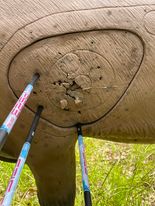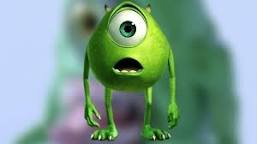At the beginning of the week, I planned on heading to Townsend, Mass., on Saturday to shoot the ASA event. I figured it would give me good practice for next weekend in Metropolis for the final stop of the ASA Pro-Ams before the ASA Classic. However, after eating lunch of Friday, those plans washed away when I got violently ill. The illness ran through my family, starting with my father, then going to my mother and finally catching up to me. It is believed that we all ate something bad and had.a bout of food poisoning. After the sickness started, I ended up in bed for the rest of Friday and the entire day Saturday, never getting out of bed on Saturday.
When my dad said that he and Wade were headed over to Massachusetts in the next morning, I told him I would go if I felt better. Well, when I woke up, I still felt extremely weak, but I decided I would attempt to shoot just so I could see targets and at least judge them. I also figured it would allow me to shoot my bow while dealing with less than ideal conditions. Who knows, maybe the hold would replicate a hold I would see in the future while on the course at a national. I always think I can learn something, and nobody has ever accused me of being smart.
I slept for the better part of the ride to the shoot. My body was feeling it, and I had no energy. When I got there, I picked up a little spunkiness when I saw many member of my archery family, especially the ones I don't get to see very often. I got to see Jon Brown, who was in town from the Midwest. It was good to catch up for a few minutes before heading out to shoot. I also got to see Sean Royster, whom I haven't seen since his trip to the Mid-Atlantic Sectionals in Hudson Falls a few years ago. Then I got to see two of my favorites, Scott Norton and Travis Williams, who always give me a good laugh when we catch up. There were a host of others it felt great to see since I've been on the road so much this year and haven't shot much in our region. Joe Santos continued his stellar year today, with a killer score for us older guys.
This entry will be short, as I'm still not feeling up to par, and I am exhausted. I was lucky enough to shoot with all unknown guys today on the black stake. I shared the stake with Tyler Thygesen and Cole Bromley. I love both of these guys, and I thoroughly enjoy their company. I always root for them to succeed. During the first half, I decided to play the game like I normally play it and call both uppers and lowers depending on how I felt about the situation.
As we progressed through the first half, I felt good about my shooting. Being so week, it was all but impossible to hold the bow well, but I battled through it and did the best I could. Getting off the first half about even, I considered it a success. Without stopping for a break, we headed right onto the second half. The humidity was picking up and the sun was blazing hot at times. Going into he second half, I decided to call all uppers just to see how it would play out. After the first half, I realized it I had called all uppers that even score would have been significantly better, as I was hitting just over the 11 on the connector rather than just under it. I figured I would play the odds and see how it played up. Before long, I was feeling really good about things, as I hit four in a 7-target stretch.
Then when we came upon the howling wolf, I told Cole and Tyler that my body had tapped out. My energy was gone, and I was toast. The two days nonstop in bed had taken their toll. I had no energy, and I hadn't eaten anything in almost two days. On top of that, the water cooler was empty when I walked up the road from the wolf to quench my thirst. My focus was gone, and I checked out for the rest of the day. I didn't purposely do it, but that's what happens when there's no gas in the tank. Your body will react just like a car's engine. When nothing is inside of the to keep them going, they just quit working. That was the case today.
Looking back at it, I'm not happy about the way things ended, but I never missed the rings by very much. I just wasn't holding well enough to capitalize on the weaker shots near the end of the day. Up until the end of the day, I was on par to have a pretty good scoring round. That should show you how quickly things can go sideways. I was certain I would finish up, but my certainty washed away with the sweat running down my back.
Here are a few pictures of my luck on the first half, followed by my luck on the second half. This is basically how the day went. It was so close from being a phenomenal day, but it just didn't fall into place. I can feel it coming. The day is coming, and I'll be ready when it arrives. I'll capture the moment, sit in the saddle and guide the horse along the rail down the homestretch. I'm finally ready. Near the end, I shot a lot of 8s, and none of them missed my much. Only one of them made me a little angry, and that was the last shot of the day. The shot broke, and I said, "Yup, got that one." Cole looked at me, and shook his head and said, "Nope. it's out the left side."
My perfect shot that hit exactly where I thought the 12 was located Orange arrow is mine. The story of my first half
After calling all uppers, I got many of them and all the rest hit where this one did
When we got to the target, I couldn't believe how far I was from it, yet the arrow hit exactly where I wanted it to hit. I guess that goes to show you what a long day on the range does. When you think you're dead center in the upper 12 and you're way right and low and your arrow is sitting well into the 8-ring, you know you just didn't see the aiming spot as you thought you saw it. Lesson of the day: Don't judge your day based on score. I've shot some of my best scoring rounds ever and felt like I never made a good shot, and I've had some low-scoring rounds but shot my bow incredibly well. Know how to make adjustments and figure out what you need take away from every shoot you attend. That will be crucial to your success.
My Thoughts on the Day
Although I know my body told me not to attend, I'm glad I went to the shoot. I got to see a lot of people who root for me, and I appreciate all of their support. All of your success is my success, and my success is your success. Having a great support group back home always makes it easier while on the road, and I appreciate and thank all of the people who spoke kindly to me today.
After I finished shooting today, I got to spend a while chatting with my friend Pete Swanney, one of the best shooters I've ever had the privilege of sharing a range with. I've always envied his ability to make shooting a bow look so easy. I often wondered over the years how he made it look so easy, and I wished I could do the same. I always though when I shot a bow, I looked like a car trying to stay on the road after hitting black ice unexpectedly. Somehow, I found a way to keep the car on the pavement, even if it wasn't pretty, and that is how I learned the most about myself. I learned that we all have our own way of doing things that gets us to where we want to go -- as long as we can repeat it time and time again.
I enjoyed my conversation with Pete today because I felt like I could talk with him about things that most others would not understand about equipment. I also trust his knowledge to understand what I was trying to explain, and he understood it perfectly. It felt great to talk about these things with someone I've valued for many years. Thanks, Pete, for the year and offering some of your thoughts. I truly appreciate it.
Pete also said he saw Dave Gravlin on the way to the shoot this morning. Dave was one of the best shooters New England had to offer back in the day, and I always knew if I could keep up with Dave, I was doing really well. He's just one of the many great ones from our region who doesn't shoot anymore, but he, like so many others, is a large part of the success I've been able to find along the way. I'm thankful for all of those people from that era as well as all of the newbies in it now.
This was the best set-up ASA course I've shot in New England. It was basically all flat ground for the most part, and the yardages were similar to a national event. With the attendance numbers up, the targets are getting pretty beat up, but it still presents an opportunity to see Delta/McKenzie targets. Using flat roads to set the courses along, it gives a better presentation to how the ASA is run.
I have three extremely busy weeks coming, and I'm looking forward to all of the challenges that will be presented in that time. I'm making a few changes to my approach, and I'll see what happens with that. The only things that stinks about shooting a bunch of events is that it leaves limited time to practice, and I've always been a person who is more passionate about the practice than the prize.








































